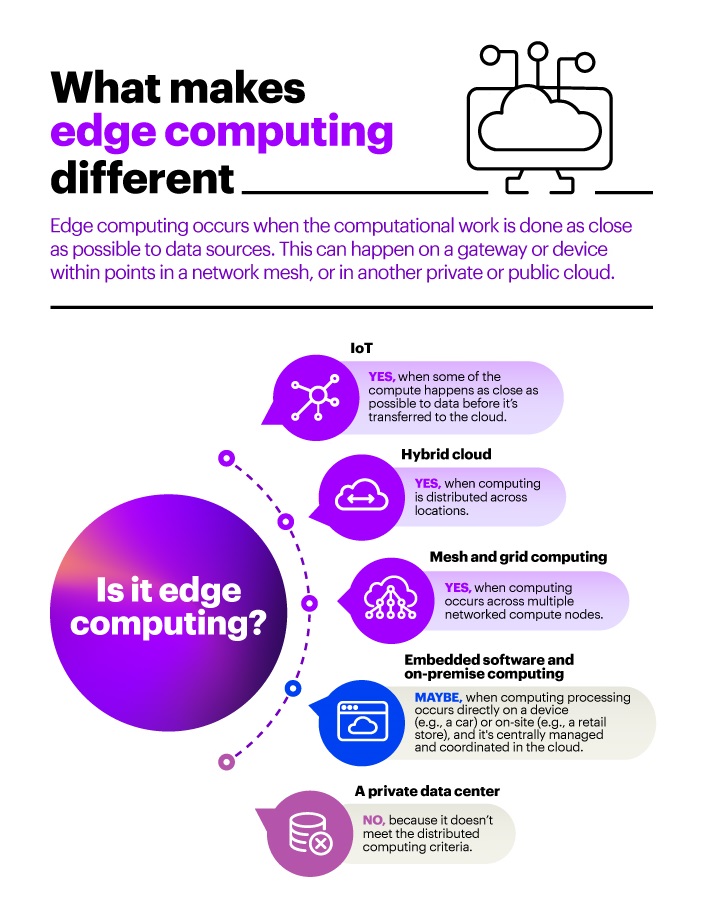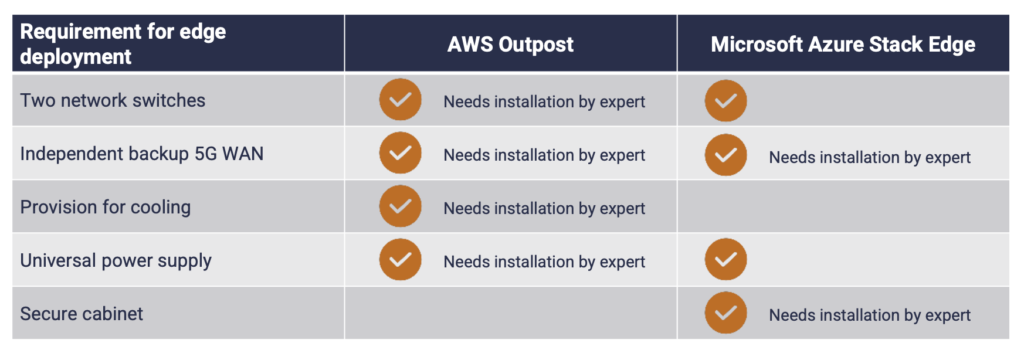In the age of technology, the concept of sustainability is gaining more importance than ever before. With the growing concern for the environment, businesses and organizations are seeking ways to reduce their carbon footprint while continuing to meet their operational requirements. Edge computing has emerged as a viable solution that can help improve sustainability by enabling more efficient and cost-effective operations.
Edge computing refers to the process of processing and storing data closer to the source, rather than transmitting it to a central location for processing. This approach reduces the need for large-scale data centers, which consume a significant amount of energy and contribute to carbon emissions. By implementing edge computing technologies, businesses can reduce their energy consumption, lower their operating costs, and improve their overall sustainability. In this article, we will explore how edge computing can be used to improve sustainability and the benefits it offers for businesses and organizations.

Edge Computing and Sustainability
Edge computing is an emerging technology that can have a major impact on sustainability. It is a form of distributed computing that can help with energy efficiency, reduce the need for physical infrastructure, and reduce the consumption of resources. Edge computing can be used to improve sustainability in many ways, from helping to reduce emissions to optimizing energy consumption.
Reducing Emissions
Edge computing can be used to reduce emissions in a number of ways. By using edge computing to process data locally, it can reduce the need to transmit data over long distances. This means that fewer emissions are produced in the process of transmitting data. Additionally, edge computing can help to reduce the need for physical infrastructure. This means that less energy is used to power the infrastructure and fewer resources are used to build it.
Edge computing can also be used to reduce the amount of energy used by data centers. By processing data locally, data centers can reduce the amount of energy they use to process data. This can lead to a decrease in the amount of energy consumed, leading to reduced emissions. Additionally, edge computing can help to reduce the amount of energy used to transmit data, further reducing emissions.
Optimizing Energy Consumption
Edge computing can also be used to optimize energy consumption. By processing data locally, it can reduce the amount of energy used to transmit data over long distances. This can lead to a reduction in the amount of energy consumed, leading to increased efficiency. Additionally, edge computing can be used to optimize the energy consumption of data centers, leading to a decrease in the amount of energy consumed.
Edge computing can also be used to optimize the energy consumption of other types of infrastructure. By processing data locally, it can reduce the amount of energy used to power infrastructure, leading to increased efficiency. Additionally, edge computing can be used to optimize the energy consumption of devices such as sensors, leading to decreased energy consumption.
Improving Efficiency
Edge computing can be used to improve the efficiency of data centers. By processing data locally, edge computing can reduce the amount of energy used to process data, leading to increased efficiency. Additionally, edge computing can be used to optimize the energy consumption of other types of infrastructure, leading to increased efficiency.
Edge computing can also be used to improve the efficiency of other types of infrastructure. By processing data locally, edge computing can reduce the amount of energy used to power infrastructure, leading to increased efficiency. Additionally, edge computing can be used to optimize the energy consumption of devices such as sensors, leading to decreased energy consumption.
Reducing Resource Consumption
Edge computing can also be used to reduce the amount of resources needed to power infrastructure. By processing data locally, edge computing can reduce the amount of energy used to power infrastructure, leading to fewer resources used. Additionally, edge computing can be used to optimize the energy consumption of devices such as sensors, leading to decreased resource consumption.
Edge computing can also help to reduce the amount of resources needed to build physical infrastructure. By processing data locally, edge computing can reduce the need for physical infrastructure, leading to fewer resources used. Additionally, edge computing can be used to optimize the energy consumption of devices such as sensors, leading to decreased resource consumption.
Increasing Reliability
Edge computing can also be used to increase the reliability of data centers. By processing data locally, edge computing can reduce the amount of energy used to process data, leading to increased reliability. Additionally, edge computing can be used to optimize the energy consumption of other types of infrastructure, leading to increased reliability.
Edge computing can also be used to increase the reliability of other types of infrastructure. By processing data locally, edge computing can reduce the amount of energy used to power infrastructure, leading to increased reliability. Additionally, edge computing can be used to optimize the energy consumption of devices such as sensors, leading to increased reliability.
Frequently Asked Questions
Edge computing is a form of computing that focuses on bringing computing power closer to the source of data, resulting in faster computing times and improved sustainability.
What is edge computing?
Edge computing is a form of computing that is designed to bring compute power closer to the source of data. Edge computing systems are designed to reduce the latency associated with cloud computing by bringing the computing power closer to the source of the data. This allows for faster processing times, as the data does not need to travel as far to get processed. Edge computing systems can also be used to improve sustainability by reducing the power consumption associated with cloud computing, as the data does not need to be transmitted over long distances.
Edge computing systems are being used to improve sustainability in a variety of ways. For instance, edge computing systems can be used to replace traditional power grids, which often rely on fossil fuels. Edge computing systems can also be used to help reduce the amount of energy used to power the internet, as they can reduce the amount of data that needs to be transmitted over long distances. Additionally, edge computing systems can be used to help reduce the amount of energy used to process data, as the data can be processed closer to the source.
How can edge computing be used to improve sustainability?
Edge computing can be used to improve sustainability in a variety of ways. By bringing computing power closer to the source of data, edge computing systems can reduce the amount of energy used to power the internet. Additionally, edge computing systems can reduce the amount of energy used to process data, as the data can be processed closer to the source. Edge computing can also be used to replace traditional power grids, which often rely on fossil fuels, with more sustainable energy sources.
Edge computing systems can also be used to reduce the amount of data that needs to be transmitted over long distances, which can help reduce the amount of energy used to power the internet. Additionally, edge computing can be used to reduce the amount of energy used to process data, as the data can be processed closer to the source. Edge computing systems can also be used to help improve the efficiency of existing systems, as they can reduce the amount of data that needs to be transmitted. This can help reduce the amount of energy used to power the internet and can help reduce the amount of energy used to process data.
What are the benefits of using edge computing to improve sustainability?
The primary benefit of using edge computing to improve sustainability is that it can reduce the amount of energy used to power the internet and process data. By bringing computing power closer to the source of data, edge computing systems can reduce the amount of data that needs to be transmitted over long distances. Additionally, edge computing can be used to replace traditional power grids, which often rely on fossil fuels, with more sustainable energy sources.
Edge computing can also help improve the efficiency of existing systems, as it can reduce the amount of data that needs to be transmitted. This can help reduce the amount of energy used to power the internet and can help reduce the amount of energy used to process data. Additionally, edge computing can be used to help reduce the amount of energy used to store data, as the data can be stored closer to the source. This can help reduce the amount of energy used to power the internet and can help reduce the amount of energy used to process data.
What are the challenges associated with using edge computing to improve sustainability?
One of the main challenges associated with using edge computing to improve sustainability is the cost of implementing the technology. Edge computing systems can be expensive to set up and maintain, as they require specialized hardware and software. Additionally, edge computing systems can be difficult to scale, as they require a large amount of computing power to process data. Finally, edge computing systems can be difficult to maintain and secure, as they can be vulnerable to cyber attacks.
Another challenge associated with edge computing is the potential for data privacy issues. As edge computing systems store data closer to the source, there is the potential for data to be misused or mishandled. Additionally, edge computing systems can be vulnerable to cyber attacks, as they are often connected to the internet. Finally, edge computing systems can be difficult to regulate, as they can be difficult to monitor and control.
What are the potential applications of edge computing in sustainability?
Edge computing can be used to improve sustainability in a variety of ways. Edge computing systems can be used to replace traditional power grids, which often rely on fossil fuels, with more sustainable energy sources. Additionally, edge computing can be used to reduce the amount of energy used to power the internet, as it can reduce the amount of data that needs to be transmitted over long distances. Edge computing can also be used to reduce the amount of energy used to process data, as the data can be processed closer to the source.
Edge computing can also be used to help improve the efficiency of existing systems, as it can reduce the amount of data that needs to be transmitted. This can help reduce the amount of energy used to power the internet and can help reduce the amount of energy used to process data. Additionally, edge computing can be used to reduce the amount of energy used to store data, as the data can be stored closer to the source. Finally, edge computing can be used to help monitor and control energy consumption in real time, allowing for more efficient energy use.
In conclusion, edge computing has the potential to revolutionize the way we approach sustainability. By bringing computing power closer to where it’s needed most, we can reduce the energy and resource consumption associated with processing data in centralized data centers. This approach not only improves the efficiency of our computing systems but also helps to reduce our carbon footprint and improve overall sustainability. As we continue to face the challenges of climate change and resource scarcity, innovative solutions like edge computing will be critical in achieving a more sustainable future.
Despite the many benefits of edge computing, there are still challenges to be addressed, such as data security and privacy concerns. However, with continued innovation and collaboration, these challenges can be overcome. By working together, we can harness the power of edge computing to create a more sustainable world for future generations. As a professional writer, I believe that the potential of edge computing to improve sustainability is truly exciting, and I look forward to seeing how this technology will continue to evolve and shape our world in the years to come.



